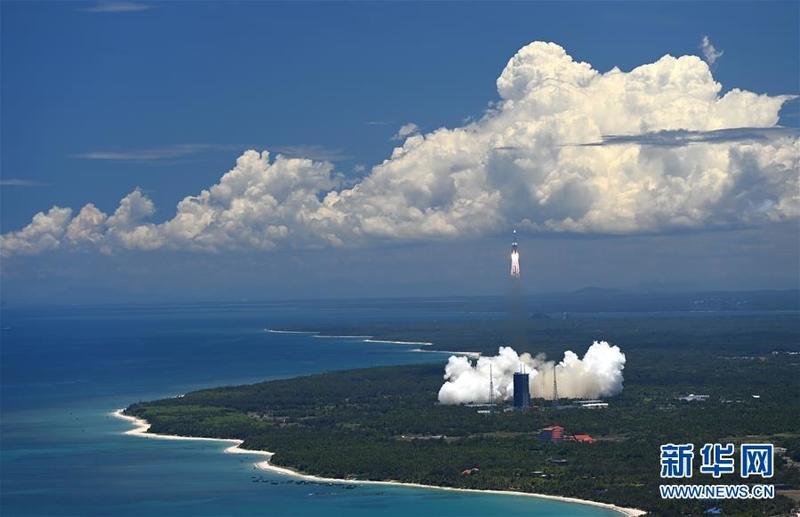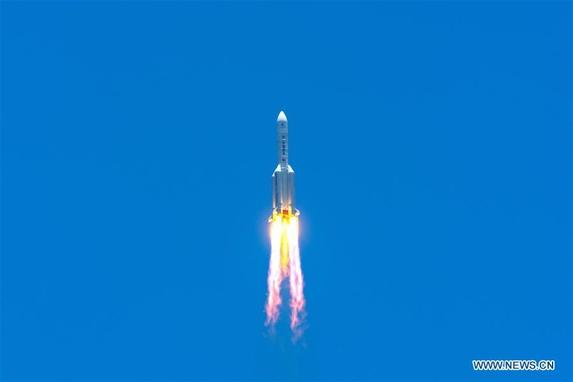WENCHANG/BEIJING - China launched a Mars probe on Thursday, aiming to complete orbiting, landing and roving in one mission, and taking the first step in its planetary exploration of the solar system.
A Long March-5 rocket carrying the Mars probe is now on an almost seven-month journey to the red planet, according to the China National Space Administration
A Long March-5 rocket, China's largest launch vehicle, carrying the spacecraft with a mass of about 5 tons, soared into the sky from the Wenchang Spacecraft Launch Site on the coast of southern China's island province of Hainan at 12:41 pm (Beijing Time).
READ MORE: China builds Asia's largest radio telescope for Mars mission
It was the first time that the Long March-5 carrier rocket, currently China's largest launch vehicle, was put into practical use after a series of trial launches. It was also the first time the Long March-5 exceeded the second cosmic velocity, the fastest China's carrier rockets have gone to date, said Li Dong, the rocket's chief designer at the China Academy of Launch Vehicle Technology (CALVT).
The rocket, codenamed Long March-5 Y4, did not separate from Tianwen-1 until it accelerated to over 11.2 km per second, the second cosmic velocity or escape velocity.
About 36 minutes later, Tianwen-1, including an orbiter and a rover, was sent into the Earth-Mars transfer orbit, embarking on an almost seven-month journey to the red planet, according to the China National Space Administration (CNSA).
As the relative positions of Earth and Mars are constantly changing, a space mission from Earth is like shooting at a moving target. The researchers have designed a record number of trajectories targeting multiple narrow time windows to ensure the probe's precise entry into the preset orbit, said Wang Jue, general director of the rocket research team at CALVT.
A total of 42 launch trajectories have been designed, more than any other Chinese space mission and the rocket can switch among them automatically, Wang said.
 A Long March-5 rocket is launched at the Wenchang Space Launch Center in south China's Hainan province, July 23, 2020. (XINHUA)
A Long March-5 rocket is launched at the Wenchang Space Launch Center in south China's Hainan province, July 23, 2020. (XINHUA)
China's first Mars mission is named Tianwen-1, which means Questions to Heaven and comes from a poem written by Qu Yuan (about 340-278 BC), one of the greatest poets of ancient China. The name signifies the Chinese nation's perseverance in pursuing truth and science and exploring nature and the universe, said the CNSA.
"The successful launch is only the first step of China's Mars mission, and we hope each of the many key steps of the long journey is completed successfully," said Geng Yan, an official at the Lunar Exploration and Space Program Center of the CNSA.
The probe is expected to reach Mars around February 2021. After it enters Mars orbit, it will spend two to three months surveying potential landing sites using a high-resolution camera to prepare for the landing in May
The key steps include slowing down close to Mars, orbiting, separating the landing platform and the rover from the orbiter, landing softly and roving.
ALSO READ: China’s Mars probe Tianwen 1 set to go
The probe is expected to reach Mars around February 2021. After it enters Mars orbit, it will spend two to three months surveying potential landing sites using a high-resolution camera to prepare for the landing in May.
The most challenging part of the mission will be the soft landing, an autonomous process of the probe lasting seven to eight minutes. The probe will use its aerodynamic shape, parachute and retrorocket to decelerate and buffer legs to touch down, said Geng.
After the landing, a rover will be released to conduct scientific exploration with an expected lifespan of at least 90 Martian days (about three months on Earth), and the orbiter, with a design life of one Martian year (about 687 days on Earth), will relay communications for the rover while conducting its own scientific detection.
Chinese space engineers and scientists have chosen a relatively flat region in the southern part of the Utopia Planitia, a large plain, as the potential landing zone.
"The reason we selected this place is that it has both the conditions for a safe landing and scientific research value. The place has not been investigated by other countries, so the scientific data can be shared with other countries to enrich the world's understanding of Mars," Geng said.
Earlier research showed that the potential landing site might be the edge of an ancient ocean or lake in the early history of Mars. Chinese scientists are looking forward to finding more evidence of water-ice.
 People watch as a Long March 5 rocket carrying China's Mars probe launches from the Wenchang Spacecraft Launch Site in south China's Hainan province, July 23, 2020. (YANG GUANYU / XINHUA)
People watch as a Long March 5 rocket carrying China's Mars probe launches from the Wenchang Spacecraft Launch Site in south China's Hainan province, July 23, 2020. (YANG GUANYU / XINHUA)
The scientific goals include mapping the morphology and geological structure, investigating surface soil characteristics and water-ice distribution, analyzing the surface material composition, measuring the ionosphere and the characteristics of the Martian climate and environment at the surface, and perceiving the physical fields and internal structure of Mars.
Mars is at the forefront of international deep space exploration, Geng said. Mars exploration could help improve human ability to go deeper into space and provide first-hand data for major scientific research such as the origin and evolution of the solar system and life.
INFOGRAPHIC: What do we know about Mars?
Pushing forward deep space exploration with Mars as the starting point could help promote China's development through innovation, said Geng Yan, an official at the Lunar Exploration and Space Program Center of the China National Space Administration
"Previous explorations have found evidence of water on the planet. Does this indicate there is or was life on Mars, or Mars is the past or the future of Earth? These questions are key goals of Mars research and are of great significance in understanding life and the evolution of Earth," Geng said.
Mars is also a priority target for manned landing missions other than the moon, as it can be reached using existing space capabilities and its environment is closest to Earth in the solar system, Geng said.
The mission will spur the enthusiasm of Chinese scientists to study other planets and make unique contributions to scientific progress, he said.
Pushing forward deep space exploration with Mars as the starting point could help promote China's development through innovation, he added.
Mars exploration is innovative and challenging. It needs basic technologies concerning materials, components, structures and instruments for extreme environmental conditions. It needs breakthroughs in artificial intelligence, autonomous navigation, precise control, as well as remote measurement, control and communication technologies.
Through transformation and application, these new technologies will help improve human life, and set new frontiers for social development by driving leaps in fields such as science and technology, ideology and culture, he said.
"Earth is the cradle of humanity, but we cannot stay in the cradle forever. It's important we have the ability to get out. Only by learning to fly, can we have a better future," said Li Dapeng, a spaceflight enthusiast from north China's Hebei province.
"The mission requires tens of thousands of steps operated correctly for complete success, quite a test for engineers and technicians. It might fail on the first try, but let's hope we're lucky," Li said.
 A Long March 5 rocket carrying China's Mars probe lifts off from the Wenchang Spacecraft Launch Site in south China's Hainan province, July 23, 2020. (CAI YANG / XINHUA)
A Long March 5 rocket carrying China's Mars probe lifts off from the Wenchang Spacecraft Launch Site in south China's Hainan province, July 23, 2020. (CAI YANG / XINHUA)
The orbiter is equipped with seven kinds of scientific instruments: two remote-sensing cameras, Mars-Orbiting Subsurface Exploration Radar, Mars Mineralogy Spectrometer, Mars Magnetometer, Mars Ion and Neutral Particle Analyzer, and Mars Energetic Particle Analyzer.
The six-wheel solar-powered rover, which looks like a blue butterfly and weighs 240 kg, carries the Terrain Camera, Multispectral Camera, Mars-Rover Subsurface Exploration Radar, Mars Surface Composition Detector, Mars Magnetic Field Detector and Mars Meteorology Monitor.
The Long March-5 rocket uses environment-friendly propellants, including liquid oxygen, liquid hydrogen and kerosene. It has a takeoff mass of 869 tonnes and can carry a payload of 14 tonnes to a geostationary transfer orbit.
"Relying on the strong carrying capacity of the Long March-5, China will push its deep-space exploration from the moon to the planets," said Li Minghua, top director of the Long March-5 team at CALVT.
Previously, the Long March-5 successfully launched the Shijian-20 satellite. The Long March-5B carrier rocket, a modified version, sent China's new-generation manned spaceship for test into space.


